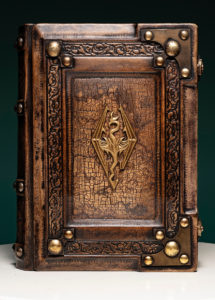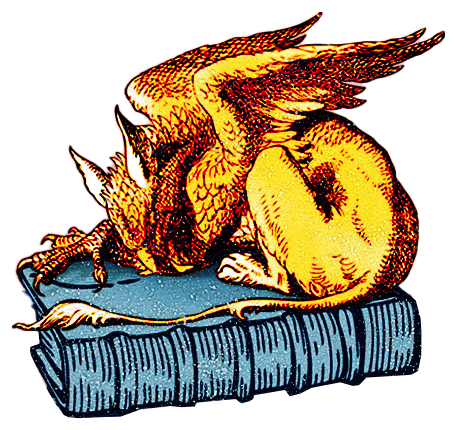Magical Librarian — Excerpts
Perhaps all the dragons of our lives
are princesses
who are only waiting to see us once
beautiful and brave.
— Rainer Maria Rilke

Meddle not
in the affairs of dragons,
for you are crunchy
and good with ketchup.
— Tee shirt seen at a Renaissance Faire
from the Prologue —
Skirting a crowd of excited students, a whitehaired woman hobbled up the grand staircase of the College of Magic. If anyone had noticed her, she would have looked grandmotherly and benign (she wasn’t), like someone who had an appointment upstairs (she didn’t). By the time she arrived at the third floor, the shouts and chatter from the students echoed up an empty staircase. The long hallway lay shadowy and deserted.
Outside a pair of ornately carved doors, she paused, tilted her head to listen, then smiled (it was not a nice smile). From inside the Rare Book Room emanated a high-pitched, rhythmic screech, like a rusty cart being rolled back and forth.
When she flicked a finger, the noise stopped.
from Chapter 1 —
 “If you want to see a powerful book, come look at the Tractatus,” I said. “I know you saw it on your class tour, but then I didn’t have this fancy little mag.”
“If you want to see a powerful book, come look at the Tractatus,” I said. “I know you saw it on your class tour, but then I didn’t have this fancy little mag.”
A moment later, Trudy and I stood side by side, peering down at the library’s prize possession: Albert Segundus’ famous bestiary, the Tractatus Magnificans, the most complete encyclopedia of magical animals produced in the Middle Ages. Libraries all over Europe owned copies, but this was Albert’s original, written in his own hand. Acquiring it for Tulsa’s library had taken me two years of hard negotiating (plus way too many cocktail parties with donors). I still wasn’t used to the splendor of its illuminations or the ceaseless pulse of its magic.
The Tractatus lay open to my favorite spot, two large pages of European dragons. Down one side of each page, in elaborate Gothic script, ran descriptions of three dragons, with their habitats, properties, and sightings. Next to them were detailed miniatures of the dragons themselves, depicted with wings extended and claws outstretched for battle. The brilliant inks—ruby and emerald, saffron and azure—gleamed as though the paint were still wet.
“Look at this.” When I held the magometer directly over the book, the screen first went a mottled orchid color. Then it blazed with six points of a purple so fiery it seemed to throw out sparks.
from Chapter 2 —
Bright purple light pulsed through the dark room. Sleepily, I shoved my hair out of my eyes, fumbled for my cell, and pushed the button to answer. I squinted at the time—2:13 a.m.—and the caller ID—Fred, the night-time security guard for the College. The combination jolted me upright.
Before I could do more than squawk Fred’s name, his Texas twang cut over my voice, loud and urgent. “They got in! I don’t know how they did it, Doctor LaFon. I was out there patrolling, I really was. But they got in . . .”
“Slow down, Fred.” I held the cell farther from my ear. “The students got past you? They got upstairs?”
“It’s worse than—” There was an indistinct thump from Fred’s end of the phone, and then a muffled scream. “That’s the Rare Book Room!”
“They’re in the library? How in the world . . ?” Then came a whistling cry, like that of a plummeting hawk, and I drew in a ragged breath. A sound like that, coming from inside the Rare Book Room, could mean only one thing: a gryphon, with its eagle’s head, lion’s body, and huge wings. And the only place a gryphon could have come from was Albert’s Tractatus. So there were magical creatures—several of them, maybe lots of them—running amok in the library.
Including dragons, some of them fire-breathing. Growing larger by the moment. Loose in a room with students and hundreds of rare, fragile manuscripts.

